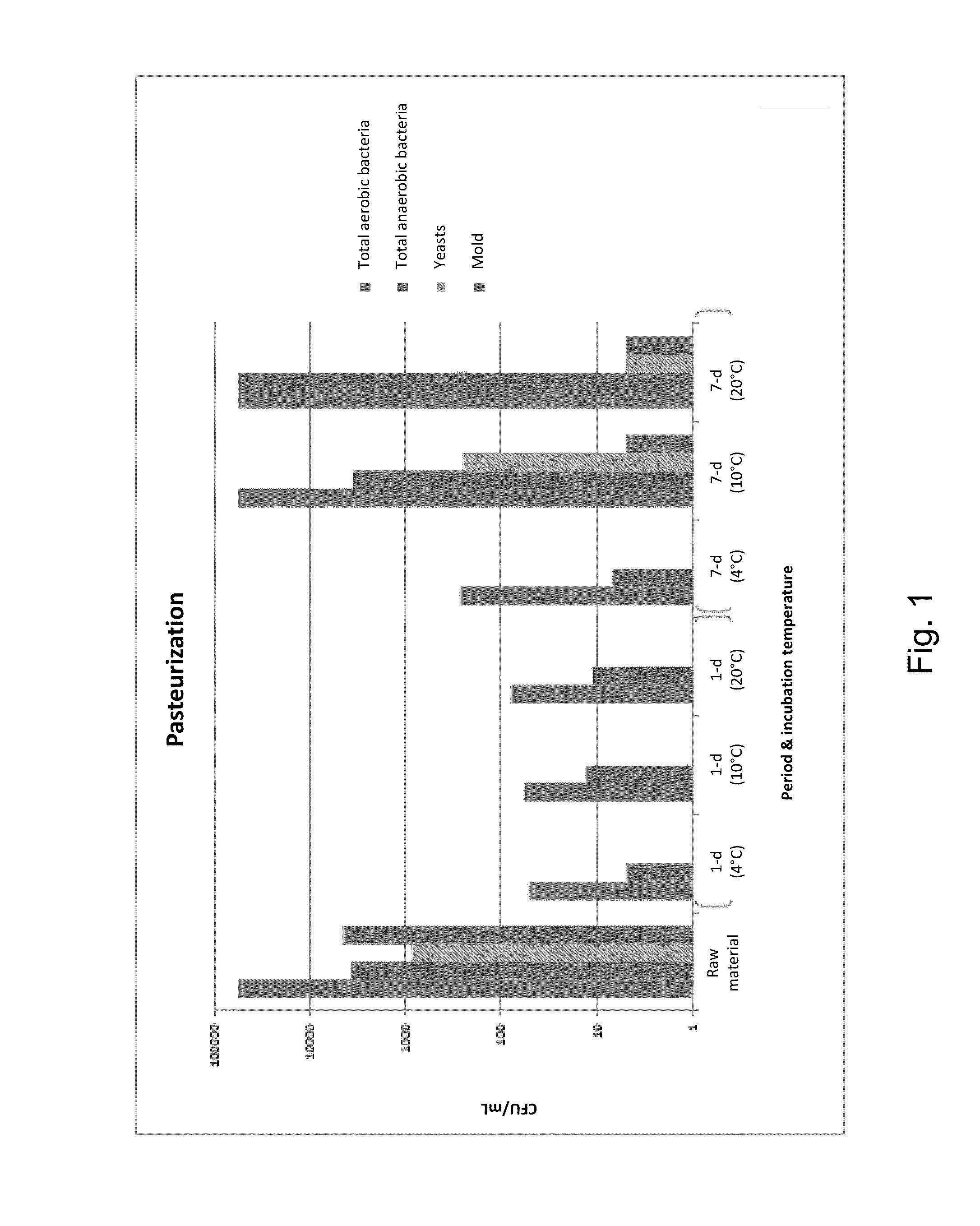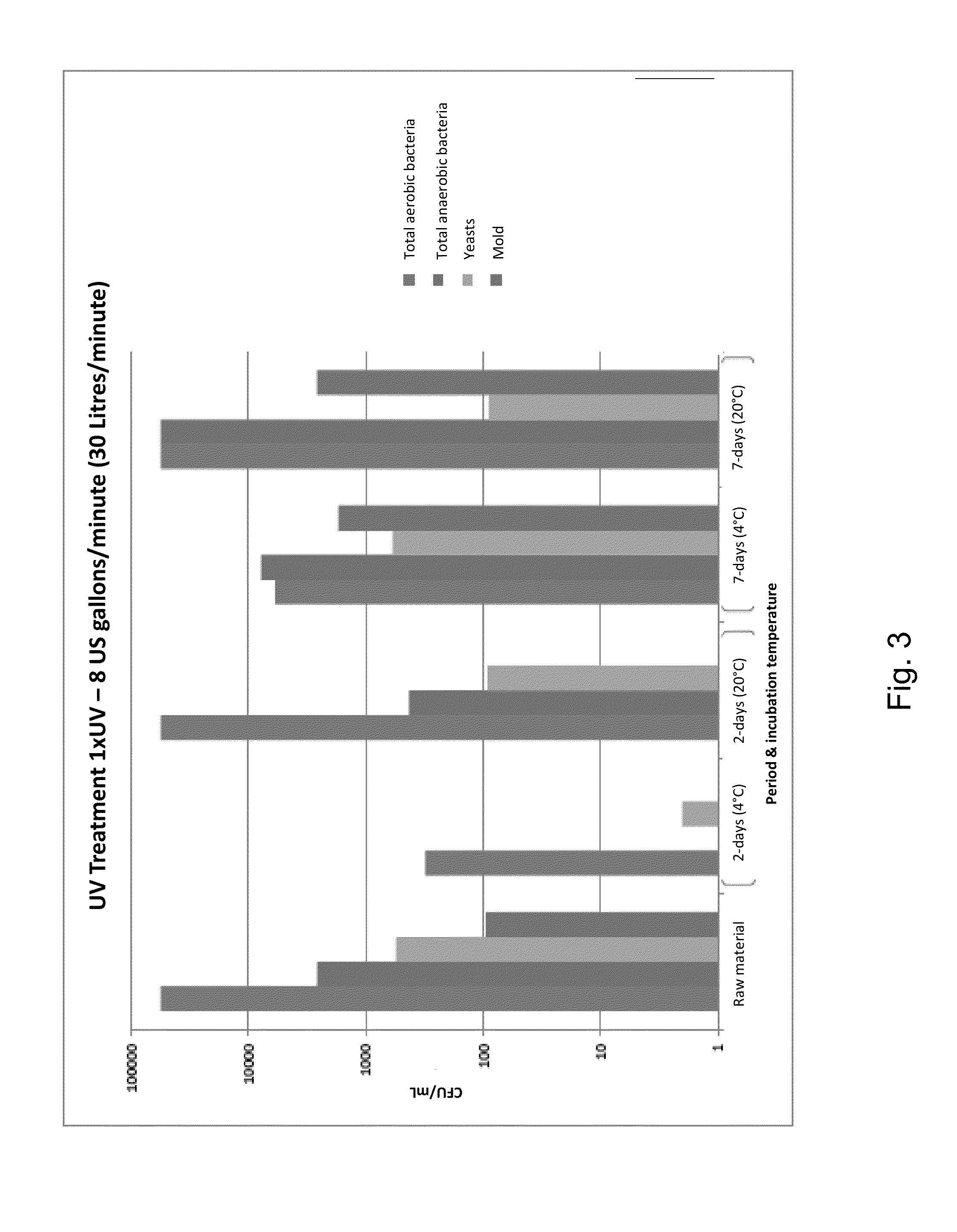Process for the pasteurization of sap and products thereof
a technology of pasteurization and sap, which is applied in the field of process for the sterilization and/or pasteurization of sap or sap concentrate, can solve the problems of increasing the viscosity of maple syrup, affecting the taste of maple syrup,
- Summary
- Abstract
- Description
- Claims
- Application Information
AI Technical Summary
Benefits of technology
Problems solved by technology
Method used
Image
Examples
example 1
Pasterization of Maple Sap
[0285]Samples of maple sap are pasteurized at 78° C. for 18 seconds in an Alfa Sterilab 4× heat exchanger P20-VB, and incubated at either 4° C., 10° C., and 20° C. for a period of 7 days. Microbiological analysis of the raw maple sap (raw material) and the samples of pasteurized maple sap is performed. FIG. 1 illustrates the total aerobic and anaerobic bacterial counts, yeasts counts, and mold counts, in Colony Forming Units per ml (CFU / ml).
TABLE 1Bacterial counts (CFU / ml) of raw or pasteurized maple sap.TotalTotalSporulatedSporulatedIncubationaerobicanaerobicaerobicanaerobicperiod andbacteriabacteriaYeastsMoldsbacteriabacteriaSampletemperature(CFU / ml)RawN / A56000370086046008material(maple sap)Pasteurized1-days525112maple sap(4° C.)Pasteurized1-days5713112maple sap(10° C.)Pasteurized1-days7911113maple sap(20° C.)Pasteurized7-days270711maple sap(4° C.)Pasteurized7-days560003500250511maple sap(10° C.)Pasteurized7-days56000560005556000maple sap(20° C.)
[0286]The...
example 2
Bactofugation of Maple Sap
[0287]Samples of maple sap are bactofugated twice in a SE102WCV bactofuge, at an output of 60 L per hour, a bowl rotation speed of 11000 turns per minutes, and a maximum treatment capacity of 3000 L / hour, and microbiological analysis of the raw maple sap (raw material) and the sample of bactofugated maple sap is performed. FIG. 2 illustrates the total aerobic and anaerobic bacterial counts, yeasts counts, and mold counts, in Colony Forming Units per ml (CFU / ml).
TABLE 2Bacterial counts (CFU / ml) of raw or bactofugated maple sap.TotalTotalSporulatedSporulatedIncubationaerobicanaerobicaerobicanaerobicperiod andbacteriabacteriaYeastsMoldsbacteriabacteriaSampletemperature(CFU / ml)Raw materialN / A56000370086046008(maple sap)Bactofugated0-day1100024091maple sapBactofugated2-days5600053011maple sap(4° C.)Bactofugated2-days56000870011maple sap(10° C.)Bactofugated2-days5600014000111maple sap(20° C.)
[0288]The results in table 2 and FIG. 2 illustrates that bactofugation i...
example 3
UV Treatment of Maple Sap
[0289]Samples of maple sap are UV treated once (1× UV) with a Hallet 30-UV Water Purification System, at an output of 30.3 L / min, and having a minimal dose of UV of 30 mJ / cm2, or UV treated twice (2×UV) with a Hallet 30-UV Water Purification System, at an output of or 75.7 L / min, and having a minimal dose of UV of 30 mJ / cm2. The samples are then incubated at either 4° C., 10° C., and 20° C. for a period of 7 days. Microbiological analysis of the raw maple sap (raw material) and the samples of pasteurized maple sap is performed. FIG. 1 illustrates the total aerobic and anaerobic bacterial counts, yeasts counts, and mold counts, in Colony Forming Units per ml (CFU / ml).
TABLE 3Bacterial counts (CFU / ml) of raw or UV treated maple sap.TotalTotalSporulatedSporulatedIncubationaerobicanaerobicaerobicanaerobicperiod andbacteriabacteriaYeastsMoldsbacteriabacteriaSampletemperature(CFU / ml)RawN / A5600026005509511material(maple sap)1xUV1xUV 2-31012111treateddays (4° C.)mapl...
PUM
 Login to View More
Login to View More Abstract
Description
Claims
Application Information
 Login to View More
Login to View More - R&D
- Intellectual Property
- Life Sciences
- Materials
- Tech Scout
- Unparalleled Data Quality
- Higher Quality Content
- 60% Fewer Hallucinations
Browse by: Latest US Patents, China's latest patents, Technical Efficacy Thesaurus, Application Domain, Technology Topic, Popular Technical Reports.
© 2025 PatSnap. All rights reserved.Legal|Privacy policy|Modern Slavery Act Transparency Statement|Sitemap|About US| Contact US: help@patsnap.com



